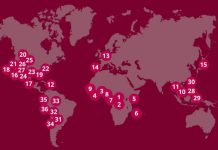
Sept. 14 (UPI) — Lakes across Europe host larger concentrations of microplastic pollution than previously estimated.
According to a new study, published Tuesday in the journal PLOS Biology, the distribution of plastic microparticles and synthetic fibers closely correlates with nearby human activity and land use.
It’s true that microplastic pollution can be carried to exotic locations — mountain peaks and deep ocean trenches, for example — but the latest findings suggest most plastic pollution is found in the waters adjacent to places where human are producing plastic waste.
For the study, scientists trawled the surface waters of dozens of European lakes for microplastics. Researchers used microscopes and spectral analysis to identify the chemical components of the plastic microparticles.
Using both previously published data and a model designed to account for the results of their trawling efforts, researchers estimated the amounts of microplastic pollution found throughout entire freshwater lake systems.
Their simulations showed microplastic pollution quadruples in bodies of water near areas with greater levels of human activity. Diminished forest cover was also associated with elevated microplastic pollution.
Some lakes are able to process microplastic pollution better than others, researchers found. Lakes with more active microorganisms hosted reduced concentrations of plastic microparticles.
“Our study provides a valuable evidence base to help prioritize monitoring and mitigation of anthropogenic debris in the world’s lakes,” researchers wrote. “As anthropogenic debris continues to pollute the environment, our data will help contextualize future work, and our models can inform control and remediation efforts.”
Studies have shown microplastics can become ingested by larval fish and work their ways up the food chain, disrupting entire ecosystems.
Even the largest aquatic species are negatively impacted by tiny bits of plastic.
“Most of our attention on plastic pollution focuses on the oceans, but we discovered that Europe’s lakes — our drinking water sources — are similarly polluted by microscopic plastics and man-made fibers,” lead author Andrew Tanentzap said in a press release.
“Our study can now help direct control and remediation efforts by identifying hotspots of microparticle pollution based on surrounding land use and water quality,” said Tanentzap, a professor of global change ecology and head of the Ecosystems and Global Change Group at the University of Cambridge.





